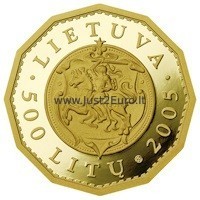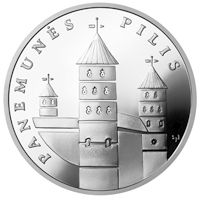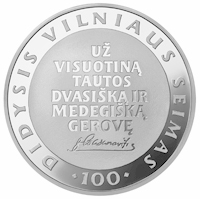500 litų auksinė moneta 2005 Lietuva – Valdovų rūmai
500 Litų auksinė moneta su dėžute ir sertifikatu
Auksas (Au 999)
Svoris– 31.10 g
Kokybė proof
Tiražas 1,000
Išleista 2005 metais
Aprašymas
The reverse of the coin depicts an Ensemble of the Palace of the Rulers of the Grand Duchy of Lithuania, encircled with the inscription LIETUVOS DIDŽIOSIOS KUNIGAIKŠTYSTĖS VALDOVŲ RŪMAI (the Palace of the Rulers of the Grand Duchy of Lithuania).
The obverse of the coin carries an image of the Coat of Arms of the Republic of Lithuania (Vytis) in the centre, a stylized version from the 16th c., which is encircled with the inscriptions LIETUVA (Lithuania), 500 LITŲ (500 litas) and 2005.
The ensemble of Vilnius Castles and the Palace of the Rulers of the Grand Duchy of Lithuania in the centre of the city represent the principal historical residence of the Grand Dukes of the ruling Jagiellonian, Gediminian and Vasa dynasties of Lithuania, and symbolises the sovereignty and prestige of the State. The restored Palace of the Rulers will maintain the continuity of the tradition of the State of Lithuania and support the status of Vilnius as a historical centuries-old capital and important political and cultural centre of Central and Eastern Europe
Archaeological research and finds confirm that the site of Vilnius Castles, both the Upper and the Lower, was already settled in the 1st millennium BC. Up to the 13th century, the buildings were mostly wooden, later replaced by stone ones. It is believed that the first and the only king of Lithuania Mindaugas might have had his residence in the castles of Vilnius in the mid-13th century. Officially, the capital of Lithuania was relocated to Vilnius by Grand Duke Gediminas in 1323. The earliest buildings, with their stone walls bound in Pre-gothic, or the socalled Baltic, way discovered on the site of the Lower Castle, primarily in the grounds of the Palace of the Rulers and the Cathedral, are normally attributed to the time when these two rulers were in power. Subsequent rulers of Lithuania – Algirdas and his son Jogaila, who later became King of Poland – also left their trace in the enlargement of Vilnius residency. Research finds in the recent decades imply that a stone-wall castle with towers was situated at the location of the Palace of the Rulers on the site of the Lower Castle as early as in the Pre-gothic and early Gothic period. Remaining stone foundations suggest that the castle was reconstructed and enlarged several times in the 13th and 15th centuries. It is still uncertain as to where the residence of Grand Duke Vytautas of Lithuania – who had a preference for Trakai – was, although a message of 1413 indicates that he certainly used to stay in the Lower Castle too. While at the peak of his power in the 15th century, Vytautas sought for the royal crown and rebuilt the Vilnius Cathedral, which had been damaged by fire, for the coronation celebrations. At this time the rulers’ residence in Vilnius was presumably reconstructed, although it is not certain which one it was – the Upper or the Lower Castle. The chronology of masonry, stylistic elements and the impressive size of the grand hall on the first floor imply that this was exactly where Vytautas’ residence in Vilnius could have been.









